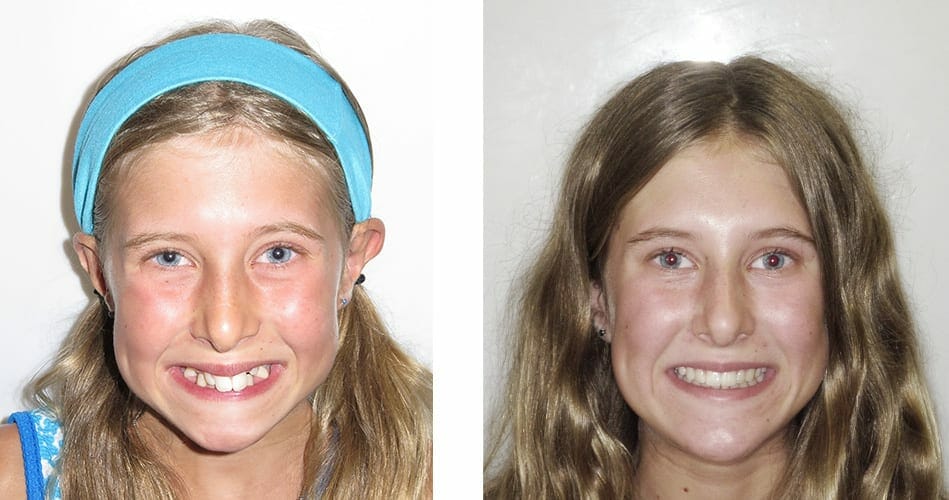People often assume that orthodontic treatment is reserved for teenagers. However, early orthodontic treatment (called interceptive orthodontics) can help children between the ages of 7 and 11 with developing orthodontic issues. In this article, we answer some of the most frequently asked questions about orthodontic treatment for children.
What Does Orthodontic Treatment Do?
A main goal of orthodontic treatment focuses on creating a healthy and normal bite. A healthy bite is when the upper and lower teeth fit together as intended. Contrary to what many people think, orthodontic treatment involves much more than simply “straightening teeth”—although this is a component of orthodontic treatment. Orthodontists focus on both tooth alignment and jaw position.
When people have a bad bite (malocclusion), they can experience problems with biting and chewing, develop speech impediments, experience difficulty breathing, develop an abnormal facial appearance, or wear their teeth excessively.
In addition to fixing the problems mentioned above, a healthy bite also makes it easier to clean teeth properly, which reduces the risk of tooth decay and gum disease. In addition, a normal bite makes chewing and function more comfortable.

How Will Orthodontic Treatment Help a Child?
By addressing all the issues mentioned above, orthodontic treatment helps provide children with clear speech, improved chewing and biting, healthy teeth and gums, and an attractive smile. All of this combines to improve health and self-esteem.
Is Orthodontic Treatment Just About Cosmetics?
No. Orthodontic treatment is about creating an improved bite and better oral health. The cosmetic benefits of achieving straight teeth are simply an added plus.
Where Do a Child’s Orthodontic Problems Come From?
Some orthodontic issues are hereditary, meaning they run in families. Some examples are crowding, spacing issues, protrusions, extra or missing teeth, and some jaw growth issues. However, some orthodontic problems are acquired by oral habits such as thumb or finger sucking, pacifier use, poor dental hygiene, poor nutrition, accidents, or early or late loss of baby teeth. Most children have a combination of inherited and acquired orthodontic problems.

Will A Child’s Teeth Straighten as They Mature?
Unfortunately, a child’s teeth usually do not straighten as they grow (although in some situations they might). In fact, left untreated, most orthodontic issues will worsen as a child grows up. The benefit of early orthodontic treatment is that results are possible in younger children who are still growing that is not possible in teens and adults.
For example, an orthodontist can use a palatal expander to widen the upper jaw to correct a back tooth crossbite relationship (when the upper jaw is excessively narrow relative to the lower jaw). This is not something that would happen without the intervention of an orthodontist.
When Is the Right Age for Orthodontic Treatment?
Although there is no “right” age for orthodontic treatment, the American Association of Orthodontists (AAO) recommends that all children visit an orthodontist no later than the age of 7. Although a child might not begin orthodontic treatment at this age, it will allow an orthodontist to get a baseline picture of emerging issues that may benefit from interceptive orthodontics. In many cases, the actual orthodontic treatment will not begin until the child is older. However, there are cases where early intervention is needed. An orthodontist will determine the appropriate timing for orthodontic treatment based on each child’s unique needs.
Why Does the American Association of Orthodontists Recommend That Children See an Orthodontist by Age 7? Isn’t This Too Young for Braces?
By the age of 7, most children have had their permanent first (6-year) molars erupt into the mouth. These 6-year molars establish how the adult bite relationship is developing. By examining a child when their permanent teeth are beginning to emerge, an orthodontist can identify developing or existing problems. Some of these problems may be able to be corrected with interceptive orthodontics, while others may require treatment later in life.
It is important to distinguish between an orthodontic check-up and orthodontic treatment. During a check-up, an orthodontist can get a sense of possible issues that may require treatment down the road. However, some issues do require early intervention at a young age to get the best results.
It is also important to know that orthodontists use appliances and devices other than child’s braces. For example, a habit appliance helps younger children from sucking their thumb or fingers. When a narrow jaw is an issue, palatal expanders can be used to widen the jaw. So, while an early set of braces is uncommon in our practice, and thus avoiding multiple sets of braces, space maintainers and other devices are used more frequently.

When Do Most Kids Get Orthodontic Treatment?
Although there is no set time for children to receive or benefit from orthodontic treatment, most children begin treatment between the ages of 8 and 14. However, the ideal time for each child will depend on their unique physiological and oral health needs.
Shouldn’t A Child’s Permanent Teeth Come in Before Seeking Orthodontic Treatment?
No. Some bite issues are more difficult or impossible to correct after permanent teeth come in or the jaw has finished growing. This is why consulting with an orthodontist no later than age 7 is important. This allows an orthodontist to identify issues that can benefit from interceptive orthodontics.
What Is Special About an Orthodontist? How Does This Differ from A Dentist?
An certified orthodontist receives additional specialized training after graduating from dental school. This training involves completing a two or three-year course of study in orthodontics at an accredited orthodontic residency program. This additional education qualifies an orthodontist to specialize in orthodontics and dentofacial orthopedics. Simply put, this means that all orthodontists are dentists, but not all dentists are orthodontists. Although some dentists offer orthodontic services (such as Invisalign), they have not received the specialized training needed to become an orthodontist.

What Does a Consultation Cost?
At Burke & Redford Orthodontists, there is no charge for an initial orthodontic consultation. This appointment can take between 30 and 60 minutes and will involve a complete exam of the patient’s teeth and surrounding structures. The doctor will then make a formal diagnosis and outline an appropriate treatment plan. Parents and children are encouraged to ask questions during the consultation.
It is also important to note that treatment may not begin immediately after this consultation. In some cases, a child will be asked to return for periodic checks to see how their teeth and jaw are developing. In other cases, treatment may begin soon after the consultation. Each patient receives a customized treatment plan depending on their unique needs. Schedule an appointment at no cost in our Temecula or Lake Elsinore office today and see if your child needs orthodontic treatment.
